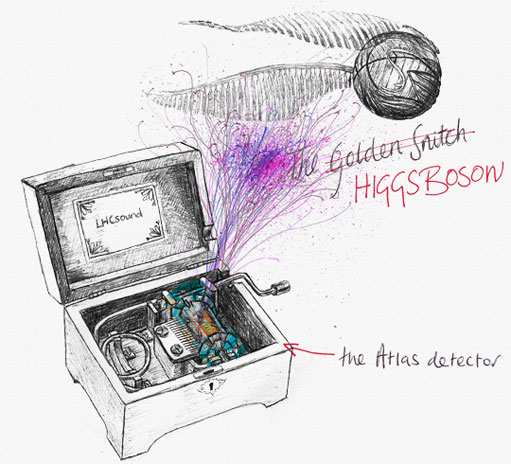
ATLAS e-News
23 February 2011
Music of the (tiny, tiny) spheres
31 May 2010

Illustration courtesy of Toya Walker.
Seven thousand tons of ATLAS detector, finally capturing a Higgs decay
is this a scenario that sounds good to you? Well now it really might: The LHC Sounds project is on a mission to ‘sonify’ real and simulated ATLAS collision data turning it into sound, allowing us to ‘hear’ particles and phenomena inside the detector, and even offering a potential future method of data analysis.
The project a collaborative venture between ATLAS physicist Lily Asquith, and a team of visual and musical artists aims to “enable non-physicists to gain a level of understanding and enjoyment from the LHC experiments”, according to Lily.
ATLAS outreach projects with this goal are many and varied, but, Lily points out, “This is something which is usually done visually, with event displays, animations and diagrams.”
It turns out that people make common associations between certain sounds and physical properties. For example, we intuitively link high pitch with high speed, and rumbling with large masses.
Mapping these sound characteristics to parameters within the data energy, distance from interaction point, angular momentum, and so on paints an aural picture of physics events in the same way that an event display depicts a visual one.
“There is a feeling amongst myself and some other physicists I have spoken to that we associate different particles with different timbres and pitches. I don‘t know why this is, I imagine it's some kind of weird personification of particles, probably due to spending too much time thinking about them!” Lily jokes.
Indeed, it was while she was attempting to “do impersonations” of different particles for friends, musicians, and fellow LHC Sounds collaborators, Eddie Real and Ed Chocolate, that the idea for the project first took hold.
The sonification itself is done by compositional music software, after the raw .xml data files have first been converted into text files full of numbers. So far, sounds on the website include a Higgs decay, several ‘sweeps’ which describe the whole detector at a given moment, and a time-stretched sonification of the Minimum Bias trigger.
New sounds are being added all the time and the plan is that the original data files also be made available through the website, to encourage anyone and everyone to try their hand at making music with ATLAS data.
“It‘s important that people can have the freedom to adjust things themselves,” explains Lily, “which is why we are in the process of creating a graphical user interface for the website to enable people to choose their own starting frequencies and so on.”
We‘ve seen what science has to offer art in this case, but does art have anything to offer science in return? Apparently so, according to Lily:
“Sonification can also be used as a physics analysis tool. Our ears are sophisticated detectors; we can determine the direction of a sound to within around three degrees, and can detect difference in frequency of around 0.3 per cent in the frequency region where our ears are most sensitive,” she says, adding: “[The technique] is especially useful for representing many dimensions or aspects of data at the same time without overwhelming the observer.”
The project is being funded by the UK‘s Science and Technology Facilities Council. For more information on the project and those involved, check out the LHC Sounds website.
 Ceri PerkinsATLAS e-News
|